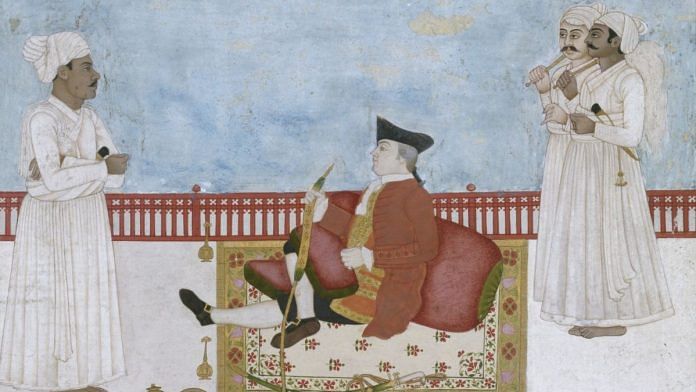As yet, in the 1680s, the EIC’s position was far from stable. Moreover, rather unwisely, it got involved in an armed conflict with the Mughals. As a result of the conflict, called the Anglo-Mughal War of 1686–90, the Company was temporarily dislodged from the west coast, and might have lost Bombay forever. The aggressive manner in which Josiah Child conducted the affairs of the Company at home had encouraged its officials in India to resort to violence and bullying more brazenly than usual in order to assert its presumed superiority, confident that their actions would be approved by their superiors in London.
There was a definite shift in the Company’s business strategy under Child’s command, with the directors opting for outright military confrontation in India. The key English functionary in the subcontinent at this time was a namesake of the EIC chief (though not related to him), John Child, who resided in Bombay as its governor, and additionally held charge of the Company’s operations in southern and eastern India. In the late 1680s, the EIC management in London, with the sanction of King James II (deposed in 1688), formally launched an offensive on two fronts. The objective of the offensive was to simultaneously extend the Company’s influence in Bengal and on the west coast. It sought to achieve this aim by exhibiting its naval prowess, commencing in 1686 with an attack on the important port of Hugli, where the EIC had maintained a regular presence since 1651 (see chapter III).
The Company was certainly in no position to take on the Mughal war machine at this stage. Mughal officials reacted by ousting the EIC from eastern India and the Coromandel and closing down all its factories in the regions. The Hugli factory had already been abandoned. With the arrival of armed ships in the Bay of Bengal, to reinforce the fleet sent out earlier, the English attempted in 1688 to capture the port of Chittagong at the eastern extremity of the Bengal coast. According to the scheme devised in London, a fortified settlement in Chittagong would be the main location in the region for the EIC’s trade. Dacca (Dhaka) in eastern Bengal was the capital of Mughal Bengal for most of the seventeenth century, and a major centre of trade and textile production. The famed muslin of Dacca was manufactured in the surrounding areas and soon became a much sought-after article for export to Europe.
Also read:
The plan for the invasion of Chittagong was a complete failure. In the west, intensified attacks by English vessels targeting Mughal shipping in the Arabian Sea called forth harsh measures to curb the Company’s piratical raids. The imperial authorities ordered a siege of Bombay, resulting in the destruction and depopulation of the settlement. Lasting for fifteen months, from early 1689 to the middle of 1690, the siege and its consequences came to be blamed on the incompetence of John Child. The blockade and occupation of Bombay was carried out by a strong force led by Sidi Yaqut Khan (his full name rarely appears in most accounts of the siege), who owed allegiance to the Mughals. Yaqut Khan was based in the impregnable fortress of Janjira located off the Konkan coast, south of Bombay.
The Europeans and their Indian and creole Indo-Portuguese dependents were confined to the Fort at the southern tip of Bombay island. A arge proportion of those who took refuge in the Fort were civilians. Many of the soldiers deserted the EIC, going over to Yaqut Khan, further weakening the English. Ultimately, the Company had to surrender unconditionally to the Mughals. Aurangzeb (r. 1658–1707) issued orders imposing a huge indemnity as the price for allowing the Company to engage in trade, and admonishing them for their defiance of Mughal authority. Reports of the debacle in Bombay were immediately suppressed. The systematic cover-up by senior functionaries of the EIC has meant that the events of the Anglo-Mughal War have been referred to in the vaguest terms in narratives of the early history of the Company’s activities in India. A typical example is the mention it receives in a much-cited work, The Cambridge History of India.
Into the war with the Moghuls, which resulted from the troubles in Bengal, the English on the western coast entered only after a long hesitancy and in a feeble manner. The seizure of some Moghul vessels brought about a rupture towards the end of 1688, with the consequence that the factors at Surat were imprisoned. Child in retaliation captured a number of richly freighted ships. Thereupon ensued a siege of Bombay by the Moghul forces, until in 1690 the English put an end to the war by a humiliating submission involving the payment of a considerable sum. Child, whose dismissal was one of the conditions of peace, died just as the negotiations were reaching a conclusion.
More recent research has shed light on the catastrophic outcome of the EIC’s misadventure, and process of erasure from the historical record of the siege which ‘has figured little in histories of the early East India Company, even though it helped precipitate one of the worst crises in the entire history of the Company’. It took quite some time for the Company to recover from the setback of the war.
 This excerpt from Amar Farooqui’s ‘The Colonial Subjugation of India’ has been published with permission from Aleph Book Company.
This excerpt from Amar Farooqui’s ‘The Colonial Subjugation of India’ has been published with permission from Aleph Book Company.



